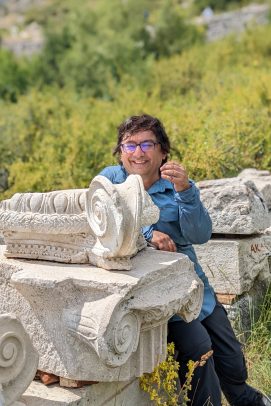New director of School of Art and Art History announced
Few people can claim to have been motivated in their studies of ancient art by growing up alongside ancient Roman aqueducts, but that’s exactly how Ömür Harmanşah, the new director of the School of Art and Art History, which is part of the College of Architecture, Design and the Arts at the University of Illinois Chicago, discovered his passion in his native Turkey.

“My family comes from a rural town where my grandparents cultivated a fruit orchard. The remains of Roman aqueducts ran in front of the orchard, and this deeply influenced me,” said Harmanşah, associate professor of art history.
Harmanşah, who joined the UIC faculty in the School of Art and Art History in 2014, was chosen to become director of the school Aug. 16, pending approval by the Illinois Board of Trustees. His early exposure to these ancient ruins led him to become an architectural historian and landscape archaeologist and to study ancient architecture, mainly Greek and Roman buildings and urban cultures.
For his doctorate, Harmanşah studied ancient art and archaeology at the University of Pennsylvania’s art history department, where he focused on Mesopotamia. He participated in many field projects, including digs in Greece and Turkey. His early work as an architect in Turkey led to fieldwork and time in the rural landscapes and “the stories of buildings,” fueled his passion. His geographic field of specialization is the ancient Middle East and the eastern Mediterranean.
“More recently I have directed my attention to environmental histories and climate change, thinking about what and how archeologists and architectural historians contribute to the most important debate of our times,” Harmanşah said. “I treat architecture, buildings and spaces as witnesses to complex histories and deep pasts.”
While studying art history and working toward his doctorate, he saw a lot of contemporary art and found it refreshing to connect ancient and contemporary art.
“I felt that there were many conceptual parallels, and thinking about contemporary art offered an amazing level of intellectual growth for me,” he said.
Before arriving at UIC, Harmanşah taught at Reed College and Brown University. He received various sabbatical and research awards, including twice receiving Koç University’s Research Center for Anatolian Civilizations Senior Fellowship, in 2009 and 2019; Brown University’s Cogut Center for the Humanities Faculty Fellowship in 2012; and the University of Texas at Austin’s Donald D. Harrington Faculty Research Fellowship in 2013. He was elected a Rising Star in Art, Architecture and the Humanities in 2016 by UIC’s Office of the Vice Chancellor for Research.
“Ömür Harmanşah has more than 18 years of experience as an accomplished educator and researcher,” College of Architecture, Design and the Arts Dean Rebecca Rugg said. “His profound scholarly knowledge working at the intersection of the ancient and contemporary, his appreciation for disciplinary intersection, and his strong management and administration skills honed in archaeological field projects make him a perfect fit for leadership in the School of Art and Art History. We are delighted to have Ömür Harmanşah take up this leadership position to lead the school into its next phase.”
His position as the new director squares with his belief in the productivity and creativity of working and thinking together and drawing people to work together from different backgrounds. Harmanşah said he is honored by the appointment and considers it a major responsibility. He said he has always been someone who draws colleagues to academic events such as conferences, workshops, collaborative projects and other social events.
He said the School of Art and Art History brings together an incredible richness of educators, staff and students from different backgrounds in studio arts, art history, museum and exhibition studies, curatorial practice, interdisciplinary arts and art education.
“Taking the leadership role in this academic unit means to me to be a convener of a creative collectivity. I aspire to support the growth and health of that creative collectivity and collective imagination,” Harmanşah said.
Part of his goal is to help the school and its students quickly adapt to the changing world around them, including social, political and environmental movements.
“This is a time of dramatic change, and our job is to … welcome change in our institution and in our curriculum,” he said.
